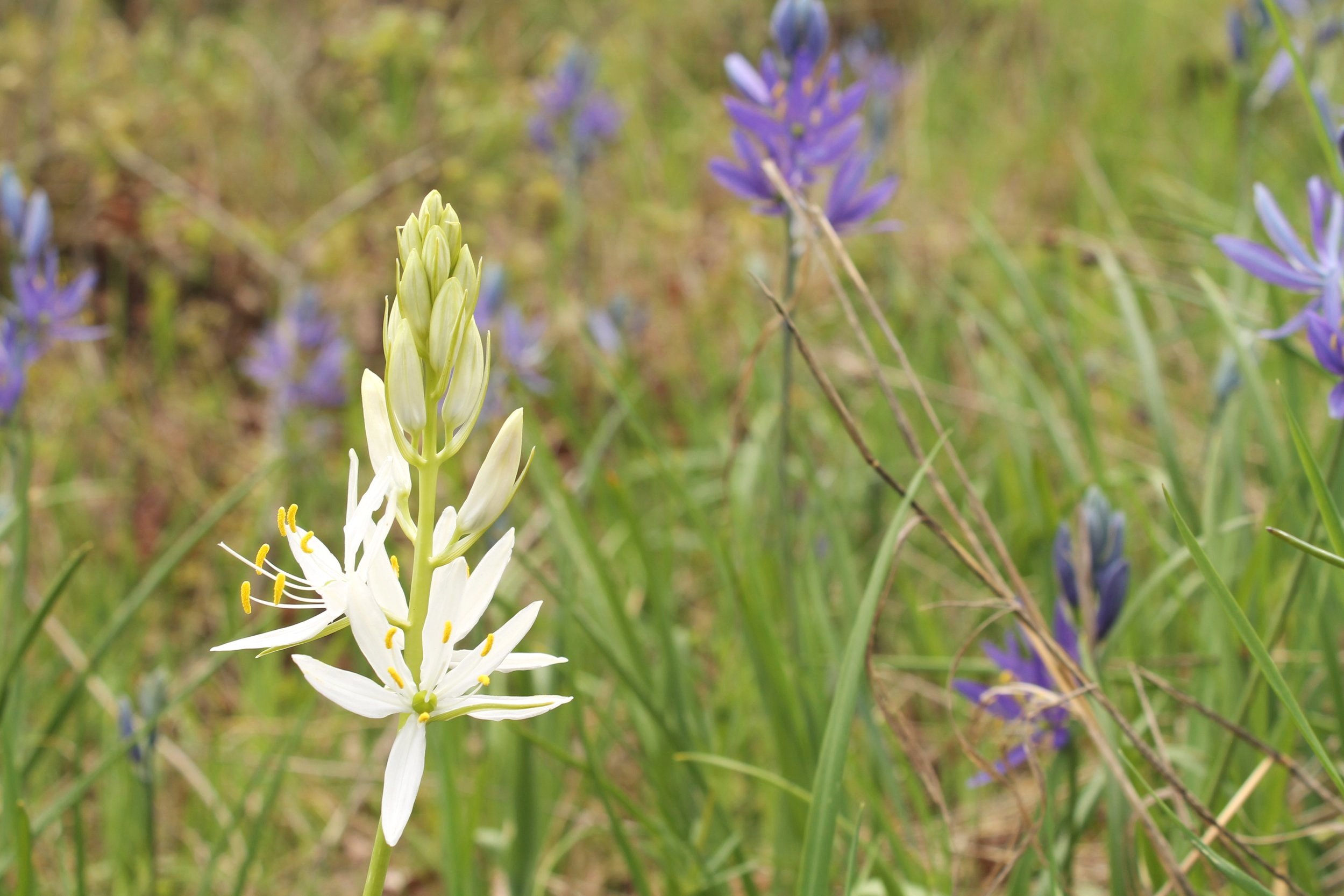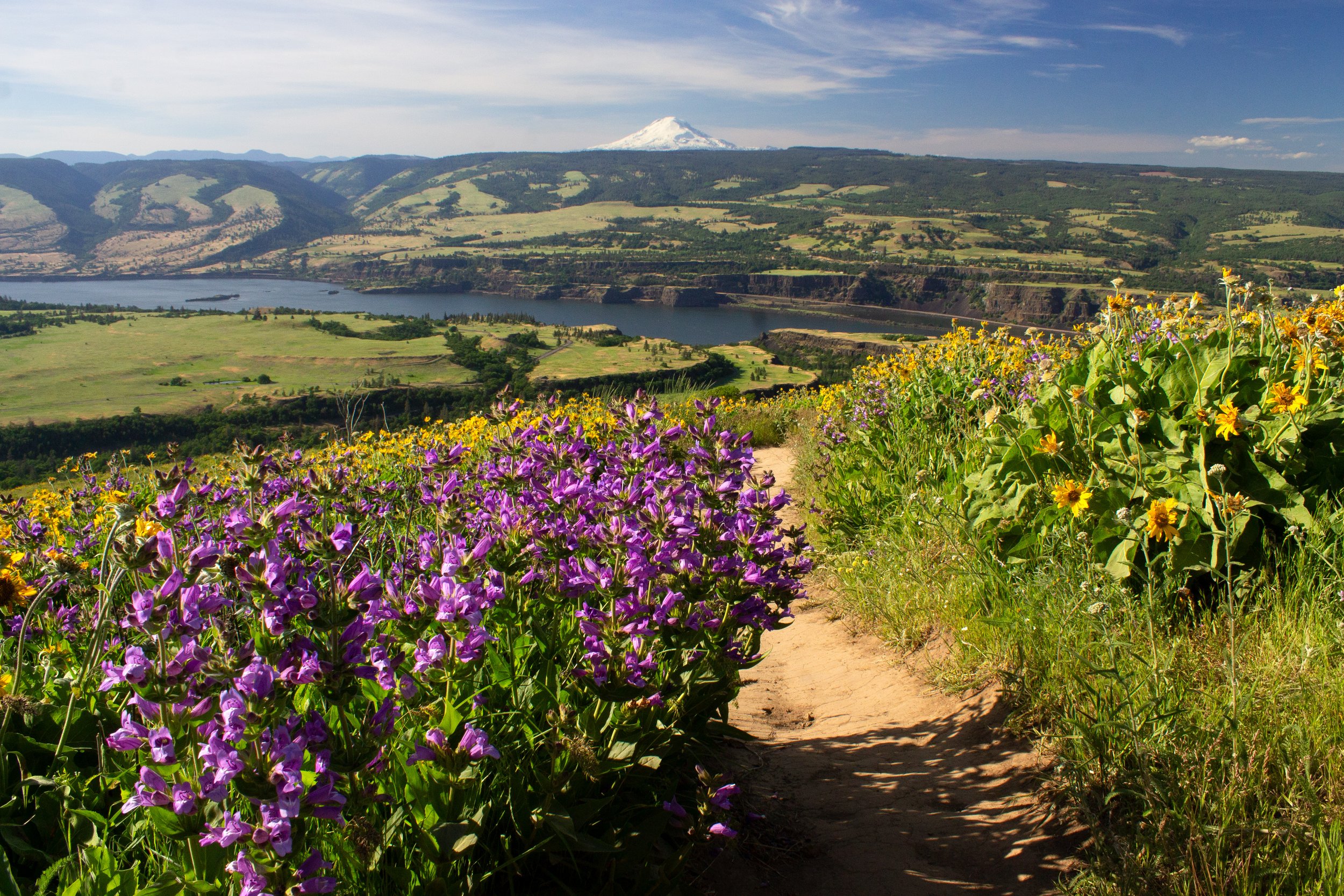Camassia Natural Area
After a long wait, camas wildflowers are finally opening around Portland, Oregon. The best place to see them is in Camassia Natural Area, a tucked-away park in West Linn where sunny meadows become carpeted with blue flowers for a short time in spring. If you miss the camas, look for rare white rock larkspur in early summer. The rest of the year, enjoy the tranquil hiking trails through forests, wetlands, and oak savannas. Here is everything you need to know about visiting Camassia Natural Area. At the end, I’ll mention a couple of other parks near Portland where you can find more camas blooms.
Common camas
Know before you go
Parking is free at Camassia Natural Area. You don’t need a pass or permit. Donations are welcome to help with the upkeep of the park. There’s a money slot at the trailhead if you choose to donate.
The parking lot is very small, with room for about 4-5 cars. Consider arriving early on a weekend day during the wildflower season.
There’s a port-a-potty next to the parking area.
Dogs are not allowed in Camassia Natural Area. If you’d like to see wildflowers with your dog, check out Lacamas Park (see below).
The loop hike at Camassia Natural Area is a great family-friendly trail but would not be good with a stroller.
Camas usually bloom in the park from around mid-April through May.
A loop trail will lead you through Camassia Natural Area. During wildflower season, the trail is one way to accommodate the increased foot traffic. You’ll do the trail counterclockwise. There are a few options for spur trails along the way, which have two-way traffic.
The loop trail is about 0.6 miles long. If you do the spur trails, the distance will be closer to 1.4 miles. The loop trail will bring you to the best scenery in the park, so don’t feel like you need to all the spurs unless you’re looking for more distance.
Please stay on the trails and don’t pick any flowers.
Watch for poison oak near the trails.
Common camas and rosy plectritis
Wildflowers of Camassia Natural Area
The star of the show at Camassia Natural Area has to be the common camas that bloom with a wild abundance in spring. You can’t miss the carpet of bright blue flowers with their 6 narrow petals and many blooms to a stalk. Camas roots are edible (but please don’t take any) and were once an important food source for Native Americans living in the Pacific Northwest. Common camas are best harvested when flowering to avoid confusion with the poisonous white-flowered death camas.
Blue-eyed Mary
The most beautiful displays in Camassia Natural Area happen when blue camas, pink rosy plectritis, and white Northwestern saxifrage bloom together in the grassy meadows. You’ll also see bright clusters of blue-eyed Mary along the trails. In wooded areas, look for trillium, violets, Oregon grapes, false Solomon’s-seal, fawn lilies, and avalanche lilies. The small ferns you see growing on the rocks are licorice ferns.
In most years, wildflower displays will be best from mid-April through May. You may spot white rock larkspur in May or June.
Spotted towhee
Animals of Camassia Natural Area
Camassia Natural Area is home to birds, reptiles, amphibians, and mammals. You’ll see the osprey nest (interpretative marker #5) on top of the cell tower to the east of the park. Tiny Anna’s hummingbirds are frequent visitors to the park. Also keep an eye out for songbirds like chickadees, wrens, cedar waxwings, and spotted towhees. Look for frogs, newts, and ducks near the wetland areas. If your timing is right, you may glimpse a deer, raccoon, or skunk in the park.
Basalt boulder on the loop trail
Geology of Camassia Natural Area
Camassia Natural Area sits on a thick bedrock of basalt. This rock formed around 14-17 million years ago when a series of lava flows from fissures in northeastern Oregon and southwestern Washington traveled down the path of the ancestral Columbia River and covered much of the area around Portland with basaltic lava. As you walk along the trails in the park, you can’t miss the craggy, dark rock surrounded by prairie grasses and flowers.
Besides wildflowers, Camassia Natural Area is a great place to see glacial erratics, a delightful term for boulders carried by glacial ice over long distances. Glacial erratics often look out of place with their surroundings, appearing too large and isolated to have been transported by natural processes. While Camassia Natural Area’s bedrock is basalt, you can find glacial erratics made of granite that came from as far away as Canada.
Massive flooding brought glacial erratics to Camassia Natural Area. At the end of the last ice age around 15,000 years ago, an ice dam broke at Glacial Lake Missoula, releasing huge amounts of meltwater across eastern Washington and into Oregon. This meltwater flooded the area around Camassia Natural Area and brought icebergs from melting glaciers, including the glacial erratics frozen within.
Camas along the loop trail
The Loop Trail
Distance: 0.6 - 1.4 miles
Elevation gain: 200 feet
Difficulty: Easy
Pass required: None
Dog friendly: No, dogs are not allowed in the park.
ADA access: No. The trail is narrow, uneven, and has a variety of surfaces.
Where to go: 4800 Walnut St, West Linn, OR 97068
Trail map at the park entrance
Basic directions: From the trailhead, go right to do the loop counterclockwise. Explore any spurs trails that look interesting and then return to the loop.
Albino camas flowers
The details:
From the unassuming gravel parking lot, you’ll see signs at the trailhead with detailed information about the plants, animals, and rocks of Camassia Natural Area. There are trail maps you can take with you to help navigate the park. Head to the right to start the loop trail counterclockwise. Follow the narrow trail for about 0.1 miles through the woods and you’ll reach the first clearing. If you hike during the spring, you’ll see the first fantastic wildflower display here. A field of camas and new spring grass blankets the ground beneath still-dormant oak trees.
After this first meadow, the trail returns briefly to the forest. You may see trillium blooming in the undergrowth. An interpretive sign describes the work done to restore and maintain the park’s oak savannas.
Trillium blooms along forested areas of the trail
You’ll soon leave the woods again and return to fields of camas. On a clear day, look for a view of Mt Hood to the east. In spring, blue-eyed Mary lines parts of the trail. There is an unmarked spur trail here heading off to the right that you may want to skip. It leads to a view of the highway.
The Mt Hood viewpoint, which was obscured by clouds during my visit
After the Mt Hood viewpoint, you’ll reach a junction where a sign points to the right towards the Bridge Trail. This spur trail leads down a couple of short, rocky switchbacks to a small stream and a field, eventually ending at the high school. Head down this trail if you’re looking to add more distance to the hike, then return to the loop trail (marked with a sign at the trail junction).
Common camas and rosy plectritis
Continuing on the loop trail, you’ll pass an enormous basalt boulder surrounded by wildflowers and then reach a short spur leading to a view of the osprey nest on top of the distant cell tower. The trees here are mostly Oregon white oak, although look for the distinctive reddish bark of Pacific madrones.
The field that starts where you see the huge basalt boulder is, in my opinion, the highlight of the hike. Delicate camas, rosy plectritis, and saxifrage cover the basalt bedrock and surround scattered boulders.
As you walk through this meadow, you’ll reach a trail junction where the loop trail connects to the Northern High School spur trail. Take a detour down this trail if you’d like some more distance. It starts with wildflowers then enters the woods and eventually reaches West Linn High School. Return to the loop trail when you’re done.
Junction with the Northern High School Trail
Continue on the loop trail, and you’ll reach boardwalks through the meadow. Surrounding these boardwalks are the best wildflower displays.
Camas, rosy plectritis, and saxifrage line the boardwalk
At the end of this meadow, you’ll return to the forest. A spur trail to your right leads to an area of meadow restoration (interpretive marker #9). No need to go past the interpretive marker on this spur, it just leads to an alternate park entrance.
Oregon fawn lily
Back on the loop trail, you’ll finish the hike by walking through the forest. There won’t be more camas but you may see trillium, fawn lilies, wood strawberries, and avalanche lilies. You’ll reach a trail junction with a spur trail that leads down to a wetland area. It’s worth taking this short detour down the Pond Trail to the wetland if it’s not too muddy. Many wildflowers grow here in spring and I saw a couple of mallards swimming in the pond.
Trillium (left) and avalanche lilies (right)
After you’ve seen the pond, return to the loop trail and continue a short distance through the woods until you are back at the parking lot.
Other parks near Portland to see camas
Camas Springs Trail
Canemah Bluff Nature Park
Distance: 0.4 - 1.7 miles
Elevation gain: 100 feet
Difficulty: Easy
Pass required: None
Dog friendly: No, dogs are not allowed on the hiking trails. They can be on leash in Canemah Children’s Park (an area with picnic tables and a playground at the park entrance).
ADA access: The 0.2-mile Camas Springs Trail is unpaved but wide, flat, and even. This trail is where the best wildflowers are, as well as the river overlook.
Restrooms: Yes, at the Canemah Children’s Park.
Where to go: 917 4th Ave, Oregon City, OR 97045
Canemah Bluff Nature Park in Oregon City offers easy access to stunning camas blooms and views of the Willamette River. Walk through the Children’s Park past the picnic area, restrooms, and playground. You’ll start seeing blue camas flowers on either side of the trail. The trail will bring you to a viewpoint overlooking the Willamette. The trail continues for a short distance through the meadow before entering the woods. The camas blooms end when you reach the woods, but you can find trillium and Oregon grape along the forested trails. There are a couple of easy, loop trails that circle the park. Look for trail markers at the junctions. You may want to seek out the Canemah Pioneer Cemetery, which is usually closed to visitors but can be seen through the fence.
First camas blooms opening at the Camas Lily Fields
Camas Lily Fields at Lacamas Park
Distance: 1.2+ miles
Elevation gain: 200 feet
Difficulty: Easy
Pass required: None
Dog friendly: Yes, leashed dogs are allowed on the trails.
ADA access: Not to the Camas Lily Fields. Parking, restrooms, and views of Lacamas Lake are accessible. The Lacamas Lake Heritage is unpaved but pretty wide, even, and flat. The trails around Round Lake are more irregular.
Restrooms: Yes
Where to go: 3344 NE Everett St, Camas, WA 98607
A 0.7-mile loop circles the Camas Lily Fields in Lacamas Park. To reach the field, start on the Round Lake Loop toward Round Lake Dam (from the parking lot, head toward the right). You’ll cross a bridge over Pothole Falls, which is particularly impressive with the high water of spring. Follow the path next to the lake. You’ll soon see a sign pointing the way to the Camas Lily Fields. Head uphill to reach a clearing filled with camas. After seeing the flowers, you can head back to the lake and continue on the loop trail around it. The hike around the lake and lily fields is about 2 miles, although you might want to add a short spur down to Woodburn Falls while you’re there.
Enjoy the camas blooms!
With love,
Emma
Check out the hikes near Portland to find trillium blooming.
Try the best wildflower hikes in Portland.
Check out the best wildflower hikes in the Columbia Gorge.



























